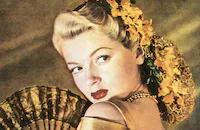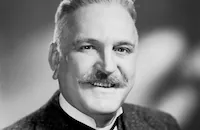Based on a novel by Elizabeth Goudge, Green Dolphin Street is a story about, as one critic phrased it, "a slip of the pen." A fugitive sailor, hiding out in New Zealand, writes to his faraway sweetheart and asks her to be his bride. The problem is, he's drunk while writing the letter and addresses it to the wrong woman, the sister of his intended, played by Lana Turner. The MGM starlet was riding high after the previous year's smash hit, The Postman Always Rings Twice (1946), and was given top billing. Nicknamed the "sweater girl" by the studio's publicity department, the typically platinum Turner appears as a brunette in Green Dolphin Street but still projects the natural sensuality that defined her celebrity. Supposedly discovered by a talent scout at a drugstore soda fountain (Leonard Maltin claimed it was at Currie's Ice Cream Parlor), Turner quickly transformed from a nubile teenager to the pin-up girl of WWII, through a series of war-themed movies for MGM.
The Postman Always Rings Twice was her breakthrough film, effectively guaranteeing her A-level movie rank. Her off-screen activity, however, made her a popular gossip column item. Julia Jean Mildred Frances Turner was married eight times (twice to the same guy), including a 7-month stint with Artie Shaw. Her life was self-described as "a series of emergencies", and no more so than in 1958, when her lover Johnny Stompanato was stabbed to death by Cheryl Crane, Turner's 15-year old daughter. Crane, apparently responding to a violent threat Stompanato made to her mother, was acquitted and the court ruled the death as justifiable homicide. Despite the controversy surrounding the case, the scandal ultimately benefited the actress's career by coming on the heels of her latest release - Peyton Place (1957) - considered by some to be her best work. The film proved to be wildly popular and garnered her an Oscar® nomination for Best Actress.
But even as early as Green Dolphin Street, Turner was embroiled in an off screen drama. During filming, she carried on a steamy affair with Tyrone Power, still married at the time. Power would ultimately end up leaving Lana for Linda Christian, who plays Lana's maid in the film!
As for Turner's other co-stars in Green Dolphin Street, Donna Reed was cast as her sister, Marguerite, and newcomer Richard Hart played the man of their affections. Reed, having earned acclaim for It's a Wonderful Life (1946), would go on to win an Oscar for her performance as an ambitious prostitute in From Here to Eternity (1953). She is best remembered, however, for her self-titled television show, reinforcing her image as "the perfect housewife," a stereotype she was powerless to shake. Green Dolphin Street was Hart's second film and, ultimately, his second to last; hailed as an up and coming leading man, his career fizzled out early and he died of a heart attack at 35. Rounding out the supporting cast were Van Heflin, cast as Hart's companion, Edmund Gwenn, Frank Morgan, and Dame May Whitty. Heflin had previously been featured with Lana Turner in Johnny Eager (1942), a movie in which his work earned him a Best Supporting Actor Oscar. Edmund Gwenn, as the sisters' father, would also receive Oscar glory, as Santa Claus in Miracle on 34th Street (1947). Frank Morgan, best remembered as the title character in The Wizard of Oz (1939), did so much character actor work for MGM that it was said he had a "lifetime contract" with the studio. By the way, Morgan, nee Francis Phillip Wuppermann, has a curious connection to the world of bartending: his family was and remains the sole North American distributors for Angostura Aromatic Bitters! Dame Whitty, once a pin-up girl like Turner, albeit during WWI, established her acting reputation with dignified British dowager roles in films like Hitchcock's The Lady Vanishes (1938) and The White Cliffs of Dover (1944).
Yet, despite the impressive qualifications of its cast, Green Dolphin Street did not score any acting nominations at Oscar time although it was the top audience draw of 1947. Instead, the kudos were reserved for the special effects, which remain visually impressive today.
Producer: Carey Wilson
Director: Victor Saville
Screenplay: Elizabeth Goudge (novel), Samson Raphaelson
Production Design:
Cinematography: George J. Folsey
Costume Design: Walter Plunkett, Valles
Film Editing: George White
Original Music: Bronislau Kaper
Principal Cast: Lana Turner (Marianne Patourel), Van Heflin (Timothy Haslam), Donna Reed (Marguerite Patourel), Richard Hart (William Ozanne), Frank Morgan (Dr. Edmund Ozanne).
BW-142m. Closed captioning.
by Eleanor Quin




































